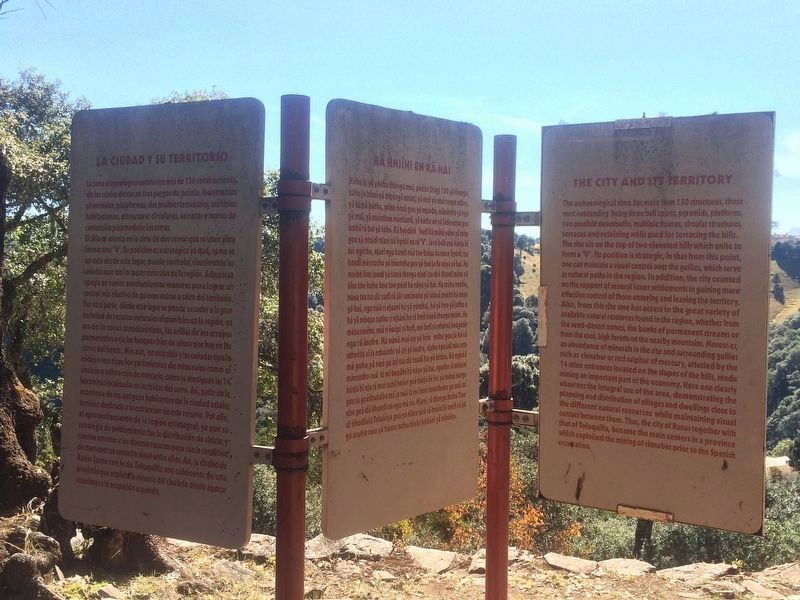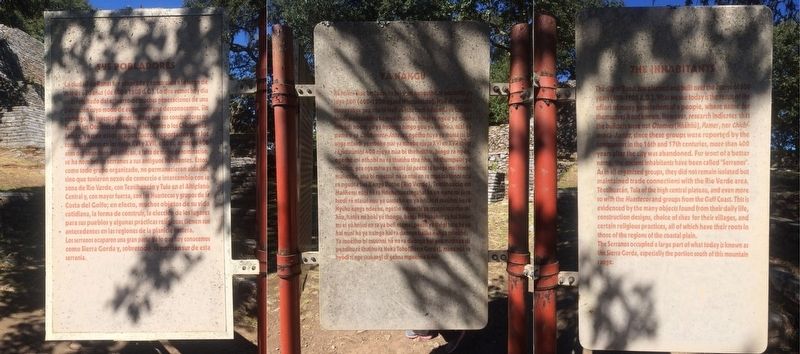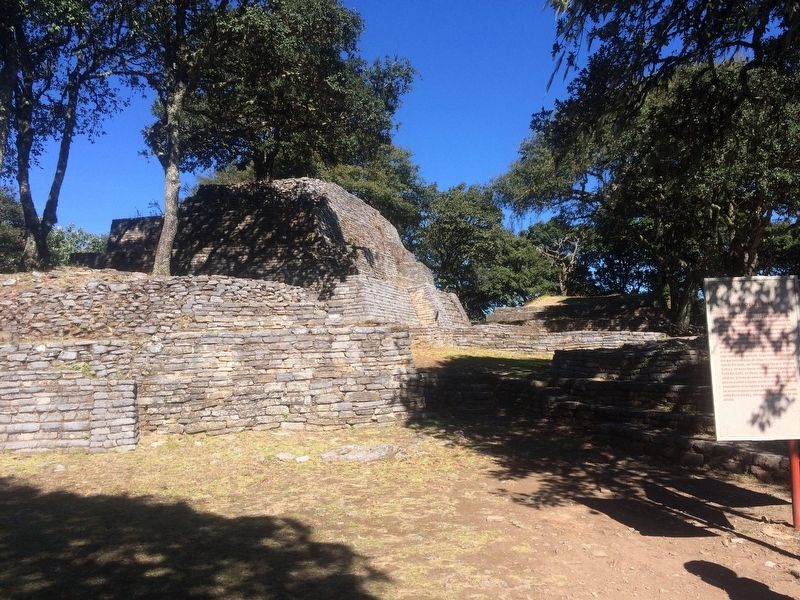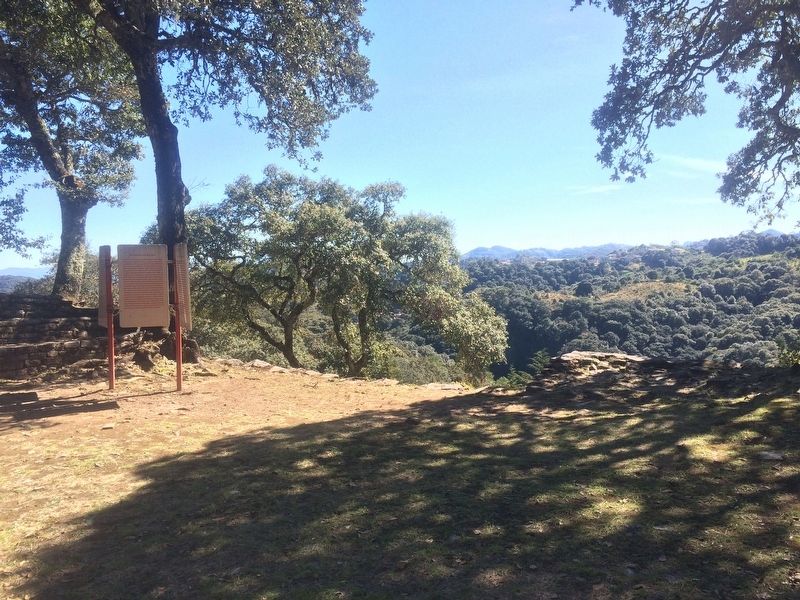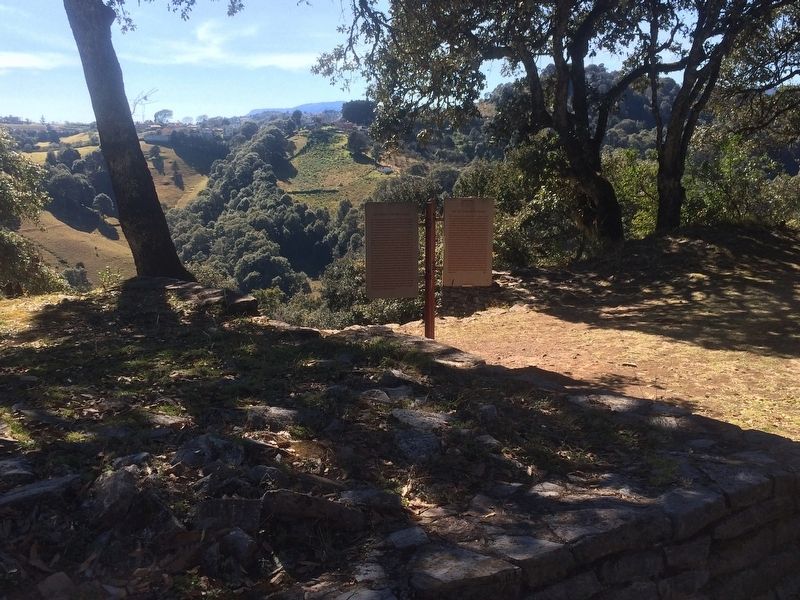San Joaquín, Querétaro, Mexico — The Central Highlands (North America)
The City and its Territory/The Inhabitants
Inscription.
La Ciudad y su Territorio
La zona arqueológica cuenta con más de 150 construcciones, de las cuales destacan tres juegos de pelota, basamentos piramidales, plataformas, dos posibles temazcales, múltiples habitaciones, estructuras circulares, terrazas y muros de contención para modelar los cerros.
El sitio se asienta en la cima de dos cerros que se unen para formar una "V". Su posición es estratégica ya que, como se aprecia desde este lugar, puede controlar, visualmente las cañadas que son los pasos naturales de la región. Además se apoya en varios asentamientos menores para lograr un control más efectivo de quienes entran o salen del territorio. Por otra parte, desde este lugar se puede acceder a la gran variedad de recursos naturales disponibles en la región, ya sea de las zonas semidesérticas, las orillas de los arroyos permanentes o de los bosques fríos de altura que hay en los cerros del frente. Más aún, en este sitio y las cañadas que lo rodean son ricos los yacimientos de minerales como el cinabrio o sulfuro rojo de mercurio, como lo atestiguan las 14 bocaminas localizadas en las faldas del cerro. Así, parte de la economía de los antiguos habitantes de la ciudad estaba también dedicada a la extracción de este recurso. Por ello, el aprovechamiento de la región es integral, ya que su estrategia de poblamiento fue la distribución de aldeas y caseríos cercanos a los diversos recursos pero con la condición de mantener un contacto visual entre ellos. Así, la ciudad de Ranas junto con la de Toluquilla son cabeceras de una provincia que explotó la minería del cinabrio desde épocas anteriores a la ocupación española.
Reverse:
Sus Pobladores
La ciudad de Ranas fue planeada y construida a lo largo de más de 600 años (de 600 a 1200 d.C.). Lo que vemos hoy día es el resultado del esuerzo de muchas generaciones de una población cuyo modo de autonombrarse desconocemos. Sin embargo, las invesigaciones indican que sus constructores no fueron los Otomíes o Hñahñu, ni los Pames o los Chichimeca-Jonáz, ya que estos grupos fueron reportados por los conquistadores en los siglos XVI y XVII, esto es, a más de 400 años del abandono del sitio; así, a falta de mejor denominación, se ha nombrado serranos a sus antiguos habitantes. Éstos, como todo grupo organizado, no permanecieron aislados, sino que tuvieron nexos de comercio e intercambio con la zona de Río Verde, con Teotihuacán y Tula en el Altiplano Central y, con mayor fuerza, con los Huastecos y grupos de la Costa del Golfo; en efecto, muchos objetos de su vida cotidiana, la forma de construir, la elección de los lugares para sus pueblos y algunas prácticas religiosas tienen sus antecedentes en las regiones de la planicie costera. Los serranos ocuparon una gran parte de lo que hoy conocemos como Sierra Gorda y, sobretodo, la porción sur de esta serranía.
Rä Hniíni en Rä Hai
Hábu ja y yaábu thongu mui, peétsi thógi 150 yä thongu, hábuja hnuúyä mteéngå nudni, yá ntei уa ntsä tonge nthoe, yä hétsä bátha, yóho ñénä geu yä mpado, nduúnthi yä ngu gá mui, yä ntuinthoe mántsanti, yä bátha en yä jädo nótse geu úmbä rá bai yä toho. Rä hyódinä 'hudi há mäñä yóho yä toho geu xä ntsúdi njani xä hyóki na rä "V". Jará befi unä hánja bi tei ngétho, njani ngu handi núä tóo báiua há núna hyódi, tsa handi mánxotho yä hiemtha geu yä nuú ja há núya yä hai. Ha neéhe fatsi juádi yä tsánä thongu njani tsa dra thandi mäna xá nho tóo kúhu bne too póni há núya yä hai. Ha mána neéhe, núua tsa tsa dä zudi rä jäi ramänaño yä tébeä peétsi há núya yä hai, ngu núä rí njaáni há yä yómhai, há yä hyo yä juthe o há yä mboza xatho rí njaáni há rá hmií núnä thongu hniini. Ha mána neéhe, núä ríñeépi rá befi, mrí befi rä nthámä hoogädo ngu ra ásufre. Há núnä mui en ya hnemtha geu ja hárä ntheétsi xija nduúnthi yä áti gá ásufre, njabu ngu údi núu reta mä goho yä neé gá áti tsa dä tsudi
ha yä bitho. Rá ngeéä mánxotho núä té mí bepäbi há núya yä hai, ngetho rä mfeéni hánja bi nja rä mui núnä hniíni gea hánja bi ñei yá mútsä nangu geu ja geétbuhábu má ja nùä tá mí honi nsokthoho ge una mí nhe geä dä nhandi na ngu mä na. Njani, rä thongu hnlini Tiue dinhódíulä Tolukiya geu yá ñaxu núä rä hnlini bi mefiräáti gá asufre núu yä hámu núbu híxki hñäáni yä mbóho.
Reverse:
Yá Nángu
Ra hnini Tiue bri feoni ha bri thoe hangutho rá nduúthi ya jeya 600 (600-1200 ngatsi Nhesukristo). Núa di hanthu mapayabye gea núa bi meti rá tota tsedi nduúthi ya bui geu híndi paátuabihu te myá thuúhu, hingi rá ngeu ya ntani mfaádi noóni ge ya hyongu híngo geu ya ñaáhñu, nixi ya pame o ya Chichimeca-Jonáces, ngétho núya ya mútsa jai bi unga mfaádi ya mboho núu ya nthebe njeya XVI en XVII thógi rá nuduúthi 400 njeya núa bi thehnitho, híngo rá ngea, ngéthe mí othobi na rá thuúhu stra ñho, bi thumpabl ya meétho, gea ngu mára ya mútsa jai peétsi rá hoóga mui hímbi muiseéhe, una bi meétsui na ra ntai en ra mpaáta thoni núa ra nguúta hai Kanga Dathe (Río Verde), Teotihuacán en Mañhemi núni há ra Ndehétsanxingahai ha en mana mí ja ra tsedi rá ntaiui núu ya uasteko en yá hniíni rí muúhni ha ra Nyúhu ñanga ndeéhe, ngétho nduúnthi ya mpépi nzántho mí hña, hánja mí hóki yá thongu, hánja mí huaáhni ya hai hábu mí ei yá hniíni en ra ya befi ntemel peétsi yá thógi tote há
ya hai núni há ya nxinga ha ira daánga bátha ñanga ndeéhe. Ya meétho bi muúhni há ra daánga hai gea mapaya dí paádihu rá thuúhu ra Noka Toho (Sierra Gorda), mana núa ra hyódi rí nge makangi di gehna mpeéhna tóho.
The City and its Territory
The archaeological zone has more than 150 structures, those most outstanding being three ball courts, pyramids, platforms, two possible steambaths, multiple houses, circular structures, terraces and retaining walls used for terracing the hills. The site sits on the top of two elevated hills which unite to form a "V". Its position is strategic, in that from this point, one can maintain a visual control over the gullies, which serve as natural paths in the region. In addition, the city counted on the support of several lesser settlements in gaining more effective control of those entering and leaving the territory. Also, from this site one has access to the great variety of available natural resources found in the region, whether from the semi-desert zones, the banks of permanent streams or from the cool, high forests on the nearby mountains. Moreover, an abundance of minerals in the site and surrounding gullies such as cinnabar or red sulphur of mercury, attested by the 14 mine entrances located on the slopes of the hills, made mining an important part of the economy. Here one clearly observes
the integral use of the area, demonstrating the planning and distribution of villages and dwellings close to
the different natural resources while maintaining visual contact between them. Thus, the city of Ranas together with that of Toluquilla, became the main centers in a province which exploited the mining of cinnabar prior to the Spanish occupation.
Reverse:
The Inhabitants
The city of Ranas was planned and built over the course of 600 years (600-1200 A.D.). What we see today is the result of the effort of many generations of a people, whose name for themselves is not known. However, research indicates that the builders were not Otomíes (Hñähñü), Pames, nor Chichimeca-Jonáz, since these groups were reported by the conquerors in the 16th and 17th centuries, more than 400 years after the city was abandoned. For wont of a better name, the ancient inhabitants have been called "Serranos". As in all organized groups, they did not remain isolated but maintained trade connections with the Río Verde area, Teotihuacán, Tula of the high central plateau, and even more so with the Huastecos and groups from the Gulf Coast. This is evidenced by the many objects found from their daily life, construction designs, choice of sites for their villages, and certain religious practices, all of which have their roots in those of the regions of the coastal plain.
Serranos occupied a large part of what today is known as the Sierra Gorda, especially the portion south of this mountain range.
Erected by Instituto Nacional de Antropología e Historia (INAH).
Topics. This historical marker is listed in these topic lists: Anthropology & Archaeology • Architecture • Man-Made Features • Native Americans. A significant historical year for this entry is 1200.
Location. 20° 55.583′ N, 99° 33.933′ W. Marker is in San Joaquín, Querétaro. Marker is on Unnamed Road. Touch for map. Marker is in this post office area: San Joaquín QUE 76550, Mexico. Touch for directions.
Other nearby markers. At least 8 other markers are within walking distance of this marker. The Sunken Patio Complex (a few steps from this marker); The Buildings 16 and 16-b (within shouting distance of this marker); The Doors of the City (within shouting distance of this marker); Archaeological Work (within shouting distance of this marker); Building Three (about 90 meters away, measured in a direct line); Ball Court Three (about 120 meters away); Las Ranas and the Access Complex (about 120 meters away); Ball Court Two (about 240 meters away). Touch for a list and map of all markers in San Joaquín.
More about this marker. The marker is at Ranas Archaeological Site to the north of the town of San Joaquín, on an unnamed but well-known road, near the "Finca de Doña Lore". This set of markers is just south of Building 16 at the main plaza of the site.
Credits. This page was last revised on January 23, 2018. It was originally submitted on January 21, 2018, by J. Makali Bruton of Accra, Ghana. This page has been viewed 108 times since then and 6 times this year. Photos: 1, 2, 3, 4, 5. submitted on January 21, 2018, by J. Makali Bruton of Accra, Ghana.
